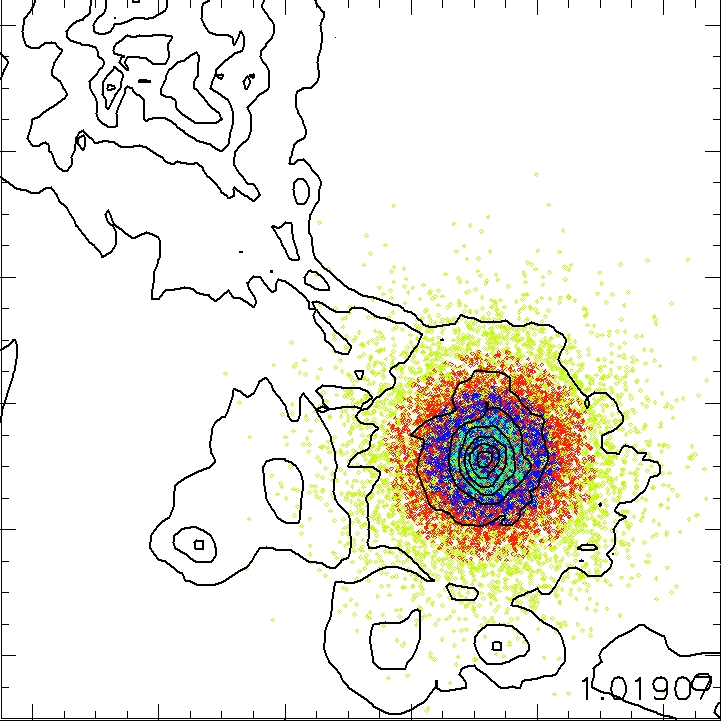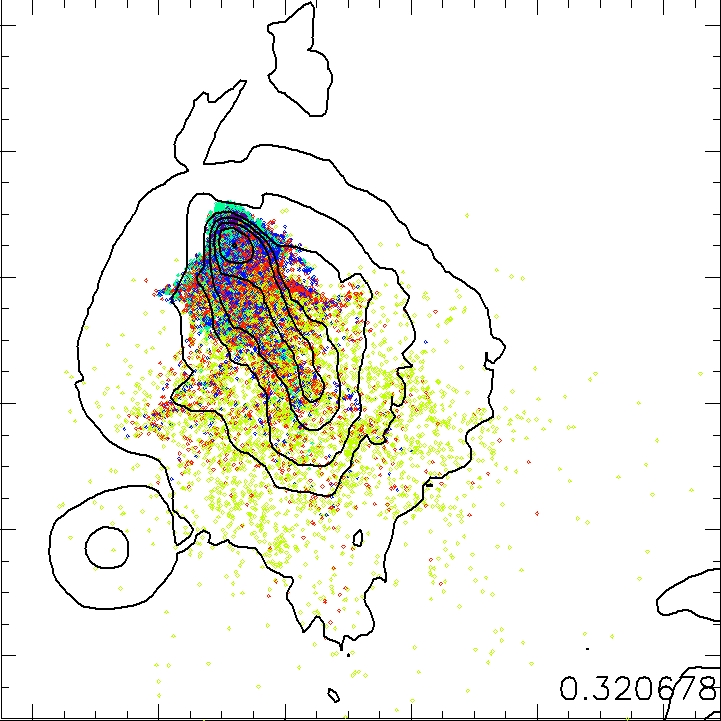Tracers in the ICM
(Vazza, Gheller & Brunetti A&A)
 |
 |
Overview
In this work we study the mixing properties of the ICM in simulated galaxy clusters, using
tracers particles that are advected by the gas flow during the evolution of cosmic structures.
This approach allows for obtaining valuable information on
the Lagrangian properties of the ICM, and allows a progress in our understanding of the
transport processes in Eulerian simulations of galaxy clusters.
7 galaxy clusters with total masses in the range M=2 - 3 10^14Mo/h and different
dynamical states were simulated with an updated version
of the ENZO code (Norman et al 2007), where an additional
refinement criterion is designed in order to reach good
spatial accuracy at shock waves up to =2 R_v from
the center of galaxy clusters (Vazza et al 2009).
In a post processing phase, we injected and follow
passive tracers, and track their spatial evolution
with high time resolution.
Numerical tests have been presented and discussed to find the
optimal strategies to inject tracers, update their positions
in time and sample the galaxy cluster volume.
We then applied this tracers technique to some interesting
problems concerning the mixing of the ICM.
First, we showed that the pair dispersion statistics has a
well constrained behavior in time:
for most of the cosmic time the separation between close couples of
tracers shows a very regular evolution in all clusters,
consistently with the basic \propto t^3/2
scaling expected for a simple turbulent model.
This finding is well consistent with the independent measurement of
3-D velocity power spectrum for the same clusters, and confirms the
picture that a sizable amount of complex subsonic motions,
correlated on cluster
scales, account for a 10-30 per cent of the thermal energy
inside $R_{vir}$ of our simulated clusters.
Second, we quantified the degree of radial mixing of the ICM
by following the evolution of tracers injected in regular shells
within the cluster volume at $z \approx 1$.
The radial mixing morphology is found to be strongly dependent on the dynamical
history of every cluster.
Large plumes of $\sim Mpc$ size, where gas matter is efficiently mixed,
are found
in the case of a major merger cluster. On the other hand more regular
and concentrated mixing profiles are measured in the case of more
relaxed clusters.
Third, we assumed a simple model of metal injection from galaxies
identified in the simulations around the clusters and
studied the metal enrichment
of the ICM by tracking the advection of ``metal'' tracers (tracers with
a different iron content, as function of their galaxy of origin) deposited
in the cluster volume.
Also in this case, the dynamical state of galaxy clusters and its
matter accretion history are found to affect the final distribution
of metal tracers at evolved epochs. In particular,
the simulated clusters show a hint of dichotomy in metallicity
distributions
between
clusters experiencing only minor mergers and clusters with major mergers, with
the latter showing a broader distribution of metals.
Finally, we simulated the emissivity of the Fe XXIII line from the center
of our clusters, using the 3--D distribution of metals produced through
our metal tracer injection (model 'c').
We reported significant departures from the simplified assumption of a constant
or a radially symmetric metallicity profile, particularly in the case
of merger systems. This stresses the importance of studying in detail
the connection between the metal enrichment history and the matter
accretion history of the ICM.